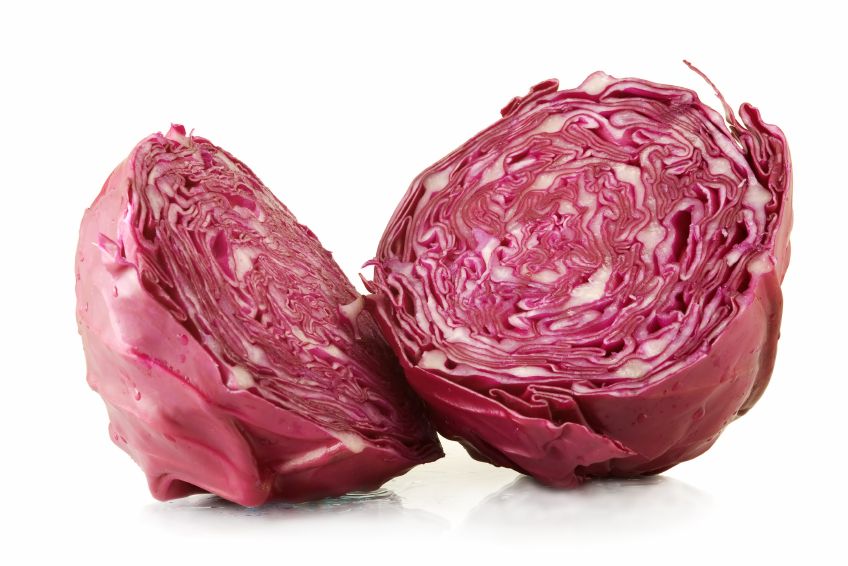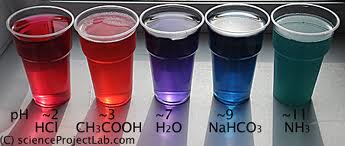Cabbage Juice pH Chemistry Lab

Acids and bases are extremely important in chemical reactions. In this experiment we will use cabbage juice to help us identify many common household chemicals as acids or bases by changes in its color. It looks cool too!

What you'll need:
- Red cabbage leaves
- Large bowl or glass pitcher
- Several small clear glass or plastic cups (paper Dixie cups are okay if you can't get clear cups)
- Strainer, colander or funnel with cheesecloth or coffee filter paper
- Scissors
- Coffee filter papers (the white ones are best)
- Boiling water
- Household ammonia
- Baking soda (sodium bicarbonate) dissolved in a little water
- Washing soda (sodium carbonate) dissolved in a little water
- Dish soap
- Laundry detergent (dissolved in a little water if you're using powder)
- Shampoo (clear is best)
- Antacid tablets or powder dissolved in a little water
- Lemon juice
- Orange juice
- Vinegar
- Seltzer water or soda
- Cream of tartar dissolved in a little water
Also be sure to ask your mom, dad or another adult to help- you can impress them with the magical color changes!
Basic Experimental Procedure:
- Tear or cut cabbage leaves into fairly small pieces and place them in a large bowl or glass pitcher.
- Pour boiling water over the leaves to cover them completely, then let this "tea" steep for several minutes until the liquid turns a purplish color.
- Once it has cooled, remove most of the leaves or filter them using a strainer, colander or funnel with coffee filter. It's the juice that we want. You could also simply spoon out the juice without removing the leaves if you like.
- Pour a little cabbage juice into each of your small plastic or glass cups. The amount you use will depend on the size of your cup, but don't use too much at first, maybe 1-2 tablespoons (15-30 milliliters or ml)
- Add a small amount (a few drops at first) of one of your test solutions to the cup of cabbage juice and note the change in color. Be sure to set aside one cup of cabbage juice that you will not add anything to so you can compare the color changes. This cup is called the "control."
- Add small amounts of other test solutions to other cabbage juice cups and note the color you get. Don't add more than one test solution to any cup- we want to see what color each makes before we do any mixing. If you started with most of the test solutions listed you should have a range of colors: red, pink, purple, violet, blue, green and possibly even yellowish green.
- Try a few other common household liquids, including plain water. What colors do they produce when added to cabbage juice?
Advanced Experimental Procedure:
- Identify a test solution that turned the cabbage juice green or blue (probably soap or ammonia, don't use baking soda yet). We'll call this a "base".
- Next identify a test solution that turned the cabbage juice red or pink (probably lemon juice or vinegar). We'll call this an "acid".
- Now using a fresh cabbage juice cup, slowly add some of your "base" solution- just as you did before- until it again turns the cabbage juice blue or green.
- Then very slowly add some of your "acid" solution to the same cup until the cabbage juice mixture begins to return to its original purple color. This is called a neutralization or titration experiment.
- Slowly continue to add more of your "acid" solution to the cup until the color changes from purple to red or pink. You've demonstrated that the color changes in this experiment are reversible.
- Try repeating the experiment backwards, i.e. start with the "acid" to make a pink or red solution, then slowly add "base" to change the color back to purple, then green or blue. Try different combinations of acids and bases.
- For one last experiment, use your cup with baking or washing soda added to the cabbage juice (it should be bluish colored). Slowly add a few drops of one of your "acid" test solutions (like vinegar or lemon juice). What happens this time?
What's Happening:
Red cabbage contains a compound called anthocyanin, which is a type of molecules called flavonoids. These compounds are often used as pigments or stains because they are very colorful, but what makes anthocyanin even more interesting is that the color it produces varies dramatically depending on the pH of the solution. pH is a way that chemists characterize acids and bases. This has to do with the concentration of hydrogen ions in the solution (acids have higher concentrations of hydrogen ions, bases lower), but for our purposes we can just consider acids and bases as opposites, and think of pH as a scale or ruler, with acids at the low end (numbers between 0-6) and bases at the high end (number typically between 8-14). A pH of 7 means the solution is neutral (neither acid nor base, or both, depending on your point of view. Pure water is neutral, with a pH=7. The lower the pH, the stronger the acid and the higher the pH the stronger the base. pH numbers close to 7 are weak acids or bases respectively. Pigments like anthocyanin that change color with pH are called indicators. Identifying the strength of acids and bases is one of the most important tests used in chemistry, as pH is one of many factors that determines how different molecules or chemicals will react when combined. [You can learn much more about pH chemistry, acids, bases and indicators in the references at the end of this experiment.]

Acidic solutions (acids) like vinegar, lemon and other citrus juices (which contain citric acid) and sodas (carbonic acid, or carbon dioxide dissolved in water) make the anthocyanin in cabbage juice turn reddish colors, while basic solutions (bases) like ammonia, baking soda and soaps turn cabbage juice bluish or greenish colors (even yellowish if the base is really strong). You can actually measure the pH by making a color chart like the one below, with red at the low end, followed by pink, purple or violet, blue, blue-green or aqua, green and finally yellowish green at the high end. Strong acids like lemon juice turn cabbage juice red, strong bases like ammonia turn it green, and other solutions generally fall somewhere in between.
Acids add more hydrogen ions to a solution, while bases remove hydrogen ions from a solution, so we can adjust the pH to any value we want by carefully combining acids and bases together. For example, if we have a vinegar solution that is strongly acidic, we can raise the pH by slowing adding a base like ammonia which will remove some of the extra hydrogen ions from the solution. If we add just a little we might change the pH from 2 to 5, making a weaker acid, but by adding a little more base we remove enough hydrogen ions to raise the pH to 7 or neutralize the solution. Finally, by adding even more base we can remove more and more hydrogen ions, raising the pH until the solution becomes a strong base. This process is completely reversible, so we could add more acid (i.e. more hydrogen ions) and lower the pH just as easily.
Of course when we mix chemicals like this other reactions may take place as well, so it's always very important to follow the instructions in an experiment like this unless you are very familiar with the chemicals you are using. That's what happens when you mixed vinegar with baking soda. These two chemicals reacted to produce carbon dioxide gas (all the bubbles you saw). Fortunately the chemicals used in this experiment are relatively safe.
Variations and Related Activities:
Anthocyanin is also found in many other foods: Red Zinger herbal tea; Grape juice or grapes; Red onions; Plums; Eggplant; Cherries; Radishes; and Blackberries. Try making your idicator solution from any of these. Do they work any better?
Another way to test for acids or bases is to use a piece of paper that has been treated with a special pH indicator. We can use our cabbage juice for this. Simply take one or two coffee filter papers (the white kind works best) and place them in your bowl of cabbage juice for several minutes (you can fold them if necessary). The juice will stain the paper purple, which means some of the anthocyanin will bond or stick to the paper. After it becomes well stained, remove the filters, gently squeeze out most of the juice, and lay them out flat on a paper towel to dry completely. Then cut the paper into small strips with scissors, about 1/2" wide by 2-3" long works well. Now you can use your indicator paper to test the pH of your test solutions, or other common household liquids. You can either dip a small portion of one strip in the test solution, or use a toothpick, Q-Tip or small straw to place a drop of the liquid onto the paper strip. It should produce the same color change as you saw in the first part of this experiment (if it doesn't, you may not have stained your coffee filter sufficiently- try soaking the paper a little longer).
References and links to more information
Others versions of this activity:
http://chemistry.about.com/od/acidsbase1/a/red-cabbage-ph-indicator.htm
http://www.sciencebuddies.org/science-fair-projects/project_ideas/Chem_p013.shtml
http://www.stanford.edu/~ajspakow/downloads/outreach/ph-student-9-30-09.pdf
More on acids and bases:
http://www.chem4kids.com/files/react_acidbase.html
http://www.funsci.com/fun3_en/acids/acids.htm
|